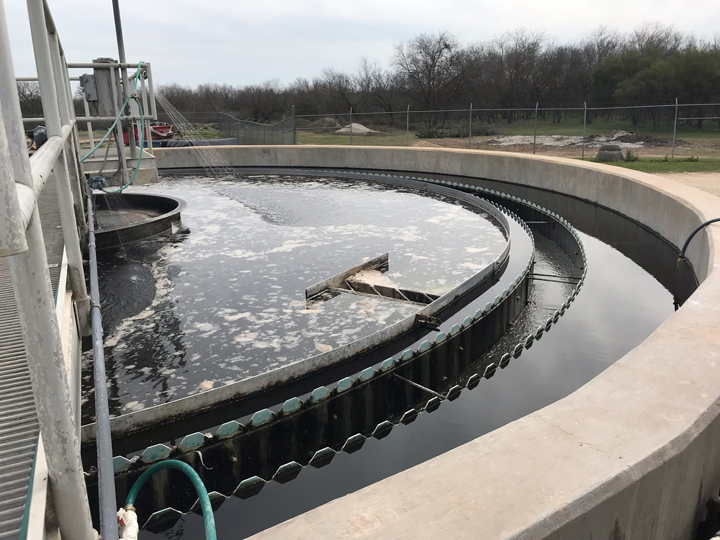Public Works Director Rob Flores’s internal report on City infrastructure painted a bleak picture of the water and wastewater facilities in Devine.
The report was obtained in full by the News, and portions of it were also shared on social media by other parties.
City Administrator John Vidaurri said that the infrastructure report was provided to City Council at the previous budget workshop, which was held during the Regular Council meeting last Tuesday, August 17, and that the report and the Utility Fund budget was slated for review during a budget workshop in the Special meeting scheduled for press night on Tuesday, Aug. 24.
A breakdown of issues listed in the report is below.
Water wells
The City has five water wells – two located on FM 1343 that pull from the Edwards Aquifer, and three inside the City limits that pull from the Carrizo-Wilcox Aquifer. Just three wells are currently in use.
The Edwards are the City’s newest and are functioning properly, though one needs an updated electrical panel in order to accept a transfer switch for a generator.

Though functioning, the Bain Well, located near the intersection of Dove Avenue and Bluebonnet Ave., is showing its age and needs an upgraded electrical panel for a transfer switch. The Bain Well doesn’t have the capacity to supply the entire town with water if necessary.
The Harrison Well, located on Tuttle Drive behind the Devine ISD bus barn, has been out of commission since its collapse in 2019 (see “New well to be drilled after Harrison failure,” in the July 3, 2019 edition of the News). Then-City Engineer Raul Garcia estimated the cost of drilling a new well between $300,000 and $350,000, which Council approved a meeting on June 25, 2019. However, a new well has yet to be dug, and according to a separate infrastructure projects report included in Council packets at the August 17 meeting, the City is “working on source of funding and location.”
The L.C. Martin Well, located behind Triple C Restaurant, had been down for some time before it was brought back online in the wake of the Harrison Well’s failure (see “Council approves $384k bid to repair water well” in the October 23, 2019 ed. of the News). According to the internal infrastructure report, raw water samples from the well have been bad and the well cannot go back online until the samples come back clean.
Wastewater Treatment Plant
The flow meter at the wastewater treatment plant, which measures the level, flow rate, and volume of water through pipes, failed and was repaired by an outside company.
“The flow-meter generates reports that we are required to submit to [the Texas Commission on Environmental Quality],” the report stated. “TCEQ was notified that the system was down. They advised we need to get the system up as soon as possible since mandatory reports are required monthly.”
Chlorine is used to help treat sewage at the treatment plant. According to the report, the building where chlorine cylinders are stored was placed over a decommissioned lift station site, and the materials used to fill it have settled over the years, leaving a void under the building of several feet.
The building also lacks electricity and cannot run exhaust fans and other criteria required by Rule 317.6 of the Texas Administrative Code.
“The companies tasked with delivery of the chlorine cylinders have the option of refusing to leave the ordered cylinders if the building is not up to code,” the report stated.
While the chlorine system’s chlorinator and ejector have been upgraded, the auto valve is failing. According to the report, the City’s auto valve is obsolete.
The report also suggested installing an alarm system to alert Public Works of any blockages in the City’s two clarifiers, which separate liquids from solids in wastewater, in order to prevent damage to drive assembly motors that cost between $40,000 and $50,000.
Broken blades on one clarifier were repaired in 2020, while drive units were installed on both clarifiers later in the year (see “Council approves up to $40,000 for clarifier repair in Emergency meeting” in the February 5, 2020 ed. of the News and “Council OKs $234,000 purchase of drive units for sewer plant clarifiers” in the May 6, 2020 ed.)
Wastewater lift stations
A lift station pumps wastewater from a lower elevation to a higher elevation – in other words, it carries raw sewage away from low-lying residences and businesses where gravity flow isn’t an option. The City’s two lift stations, located on Allman and near Food King (referred to as Super S in the report), each utilize two motors. According to the report, the City does not have any back-up motors should one fail.
“Due to heavy rains approximately 4 months ago, one of the lift station motors failed,” the report stated. “One of the backup motors was installed and has since failed from another rain event. The second back-up motor was then installed.”
Rain that enters the sewer system during storms affects the motors.
“We have attempted to locate the break in the line with no success,” the report stated. “Would like to hire a company that can use cameras to locate the break. This apparently has been an issue for numerous years.”
While the Food King lift station appears to be functioning properly, one of Allman’s pump motors is down because of a broken in-line valve.
The report recommends that both pump motors should be replaced at some point, electrical panels upgraded, and transfer switches for generators installed.
Additionally, the lift stations lack railings to prevent workers from falling into the ground chamber and do not meet safety codes.

Well Yard
The Well Yard, located on Transportation Dr., is home to the Public Works office and is also used for storage.
According to the report, the office has major leaks in the roof, a rotting floor, and Internet connectivity issues that make it impossible to monitor well status through MicroComm, the City’s supervisory control and data acquisition system (SCADA).
The gas room is not weather-proof and has holes throughout the structure, while the round room, an old ground storage tank that was converted to a break room and storage room, floods during rain.
“We had to put everything within the room on pallets to avoid damage to parts, records, etc.,” the report stated. “Appears to have mold in the structure.”
The street room is rotted and falling down and only has partial roof coverage. Chemicals, fuel, street signs, and small equipment is stored in the enclosed part of the building, while the open portion is home to a compressor, large water pump, barricades, and PVC pipe.
“We only use the shaded end of the pipe due to the compromised integrity of the area that is in full sun over many years,” the report stated.
The Well Yard also only has one toilet and sink for Public Works employees, with “No shower or area to rinse off after sewer or water leaks.”
Additionally, a wooden cover to shelter machines from the elements is rotting, and the four-foot chain link fence around the perimeter of the Well Yard has fallen down in areas, leaving the facility unsecured.
Capital Improvement Plan
“As you can see from the list there is much need for improvement,” Vidaurri said regarding Flores’s report. “There is also a need to prioritize items for improvement as there are significant expenses involved.
“Developing a prioritized list of improvements in the form of a Capital Improvement Plan will allow us to spread the expense for improvements over time. Health and safety matters will take first priority.”
By Marly Davis
Staff Writer
